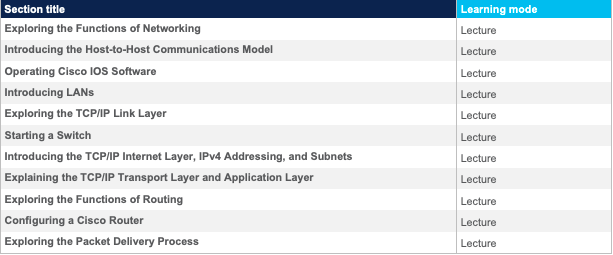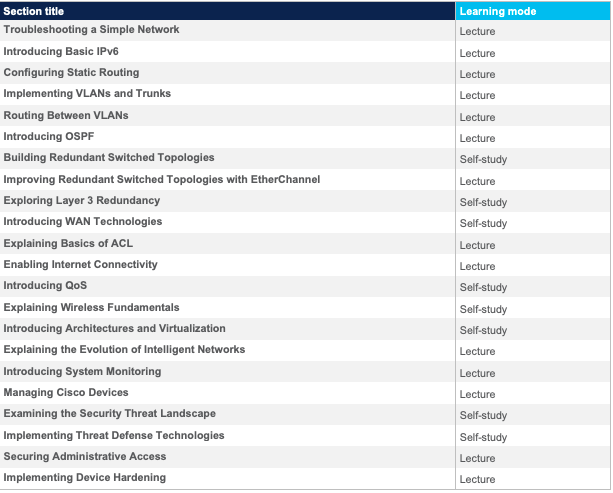Implementing and Administering Cisco Solutions (CCNA) v1.0
- Duration : 5 Days (40 Hours)
Highlights
- Certified Trainers
- Practice Labs
- Digital Courseware
- Access to the Recordings
- Experience 24*7 Learner Support.
Course Brochure Request
Implementing and Administering Cisco Solutions (CCNA) v1.0 Course Overview:
The Implementing and Administering Cisco Solutions (CCNA) v1.0 course provides a comprehensive understanding of fundamental knowledge applicable to various IT careers. This course incorporates a combination of lectures, hands-on labs, and self-study to equip learners with the skills necessary to install, operate, configure, and verify basic IPv4 and IPv6 networks. Topics covered in the course include configuring network components such as switches, routers, and wireless LAN controllers, managing network devices, and identifying basic security threats. Additionally, the course establishes a foundation in network programmability, automation, and software-defined networking.
This course helps you prepare to take the 200-301 Cisco® Certified Network Associate (CCNA®) exam. By passing this one exam, you earn CCNA certification. This course also earns you 30 Continuing Education (CE) credits towards recertification.
How you’ll benefit
This course will help you:
● Learn the knowledge and skills to install, configure, and operate a small- to medium-sized network
● Gain a foundation in the essentials of networking, security, and automation
● Earn 30 CE credits toward recertification
What to expect in the exam
The 200-301 CCNA exam certifies your knowledge and skills related to network fundamentals, network access, IP
connectivity, IP services, security fundamentals, and automation and programmability.
Intended Audience
This course is designed for anyone seeking CCNA certification. The course also provides foundational knowledge for all support technicians involved in the basic installation, operation, and verification of Cisco networks.
The job roles best suited to the material in this course are:
● Entry-level network engineer
● Network administrator
● Network support technician
● Help desk technician
Technology areas
● Networking
● Security
● Automation
Course Fee: $1,950
Guarantee To Run (GTR) Schedule
| Date/Time | Training Mode |
|---|---|
| Aug 5-Aug 9, 2024 (9am - 5pm EST) | Live Online |
| Aug 12-Aug 16, 2024 (9am - 5pm EST) | Live Online |
| Aug 19-Aug 23, 2024 (9am - 5pm EST) | Live Online |
| Aug 26-Aug 30, 2024 (9am - 5pm EST) | Live Online |
Enquire Now
Objectives
After taking this course, you should be able to:
● Identify the components of a computer network and describe their basic characteristics
● Understand the model of host-to-host communication
● Describe the features and functions of the Cisco Internetwork Operating System (IOS®) software
● Describe LANs and the role of switches within LANs
● Describe Ethernet as the network access layer of TCP/IP and describe the operation of switches
● Install a switch and perform the initial configuration
● Describe the TCP/IP Internet layer, IPv4, its addressing scheme, and subnetting
● Describe the TCP/IP Transport layer and Application layer
● Explore functions of routing
● Implement basic configuration on a Cisco router
● Explain host-to-host communications across switches and routers
● Identify and resolve common switched network issues and common problems associated with IPv4
addressing
● Describe IPv6 main features and addresses, and configure and verify basic IPv6 connectivity
● Describe the operation, benefits, and limitations of static routing
● Describe, implement, and verify Virtual Local Area Networks (VLANs) and trunks
● Describe the application and configuration of inter-VLAN routing
● Explain the basics of dynamic routing protocols and describe components and terms of Open Shortest Path
First (OSPF)
● Explain how Spanning Tree Protocol (STP) and Rapid Spanning Tree Protocol (RSTP) work
● Configure link aggregation using EtherChannel
● Describe the purpose of Layer 3 redundancy protocols
● Describe basic WAN and VPN concepts
● Describe the operation of Access Control Lists (ACLs) and their applications in the network
● Configure Internet access using Dynamic Host Configuration Protocol (DHCP) clients and explain and
configure Network Address Translation (NAT) on Cisco routers
● Describe basic Quality of Service (QoS) concepts
● Describe the concepts of wireless networks, which types of wireless networks can be built, and how to use
Wireless LAN Controllers (WLCs)
● Describe network and device architectures and introduce virtualization
● Introduce the concept of network programmability and Software-Defined Networking (SDN) and describe
smart network management solutions such as Cisco DNA Center™, Software-Defined Access (SD-Access),
and Software-Defined Wide Area Network (SD-WAN)
● Configure basic IOS system monitoring tools
● Describe the management of Cisco devices
● Describe the current security threat landscape
● Describe threat defense technologies
● Implement a basic security configuration of the device management plane
● Implement basic steps to harden network devices
Outline
This class includes lecture sections and some self-study sections. In instructor-led classes, lectures are delivered
in real-time, either in person or via video conferencing. In e-learning classes, the lectures are on recorded videos.


Lab outline
● Get Started with Cisco Command-Line Interface (CLI)
● Observe How a Switch Operates
● Perform Basic Switch Configuration
● Implement the Initial Switch Configuration
● Inspect TCP/IP Applications
● Configure an Interface on a Cisco Router
● Configure and Verify Layer 2 Discovery Protocols
● Implement an Initial Router Configuration
● Configure Default Gateway
● Explore Packet Forwarding
● Troubleshoot Switch Media and Port Issues
● Troubleshoot Port Duplex Issues
● Configure Basic IPv6 Connectivity
● Configure and Verify IPv4 Static Routes
● Configure IPv6 Static Routes
● Implement IPv4 Static Routing
● Implement IPv6 Static Routing
● Configure VLAN and Trunk
● Troubleshoot VLANs and Trunk
● Configure a Router on a Stick
● Implement Multiple VLANs and Basic Routing Between the VLANs
● Configure and Verify Single-Area OSPF
● Configure and Verify EtherChannel
● Improve Redundant Switched Topologies with EtherChannel
● Configure and Verify IPv4 ACLs
● Implement Numbered and Named IPv4 ACLs
● Configure a Provider-Assigned IPv4 Address
● Configure Static NAT
● Configure Dynamic NAT and Port Address Translation (PAT)
● Implement PAT
● Log into the WLC
● Monitor the WLC
● Configure a Dynamic (VLAN) Interface
● Configure a DHCP Scope
● Configure a WLAN
● Define a Remote Access Dial-In User Service (RADIUS) Server
● Explore Management Options
● Explore the Cisco DNA™ Center
● Configure and Verify NTP
Configure System Message Logging
● Create the Cisco IOS Image Backup
● Upgrade Cisco IOS Image
● Configure WLAN Using Wi-Fi Protected Access 2 (WPA2) Pre-Shared Key (PSK) Using the GUI
● Secure Console and Remote Access
● Enable and Limit Remote Access Connectivity
● Secure Device Administrative Access
● Configure and Verify Port Security
● Implement Device Hardening
Before taking this course, you should have:
● Basic computer literacy
● Basic PC operating system navigation skills
● Basic Internet usage skills
● Basic IP address knowledge
There are no formal prerequisites for CCNA certification, but you should make sure to have a good understanding of the exam topics.
Discover the perfect fit for your learning journey
Choose Learning Modality
Live Online
- Convenience
- Cost-effective
- Self-paced learning
- Scalability
Classroom
- Interaction and collaboration
- Networking opportunities
- Real-time feedback
- Personal attention
Onsite
- Familiar environment
- Confidentiality
- Team building
- Immediate application
Training Exclusives
This course comes with following benefits:
- Practice Labs.
- Get Trained by Certified Trainers.
- Access to the recordings of your class sessions for 90 days.
- Digital courseware
- Experience 24*7 learner support.
Got more questions? We’re all ears and ready to assist!
Request More Details

